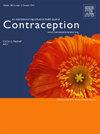ABORTION TRENDS AND METHODS IN GEORGIA OVERALL AND BY GESTATIONAL DURATION, 2010-2022
IF 2.3
2区 医学
Q1 OBSTETRICS & GYNECOLOGY
引用次数: 0
Abstract
Objectives
We aimed to estimate trends in annual and monthly abortion counts, abortion method, and gestational duration of abortions (<6 weeks vs. ≥6 weeks) in Georgia from 2010 to 2022, a period of increasing state gestational restrictions on abortion access.
Methods
Using aggregated data from the Georgia Department of Public Health’s Induced Termination of Pregnancy files from January 1, 2010 to December 31, 2022, we estimated changes in annual and monthly abortion counts and annual counts of abortions per method, overall and at <6 weeks vs. ≥6 weeks. We used Poisson regression to estimate annual and monthly abortion trends and linear regression to assess annual trends in abortion methods.
Results
Between 2010 and 2022, there were 452,275 abortions in Georgia. Abortions at <6 weeks increased from 7.3% of abortions in 2010 to 35.3% in 2022 (17.6% annual increase; 1.36% monthly increase; p<0.001); changes in abortions at ≥6 weeks were not statistically significant. Monthly data revealed seasonality, with most abortions across gestational durations happening between January and March. Medication abortion increased from 7.3% of all abortions in 2010 to 62.4% in 2022 (β=2,203.6 (95% CI, 1,877.6–2,529.6)), increasing from 26.1% to 83.3% for abortions occurring before 6 weeks (β=780.3 (95% CI, 448.2–1,112.4)) and from 5.9% to 51.1% for abortions occurring at 6 weeks and beyond (β=1,423.4 (95% CI, 1,119.3–1,727.5)).
Conclusions
People in Georgia accessed abortion care earlier in pregnancy as medication abortion use and state policy restrictiveness increased. More research is needed to measure impacts of post-Dobbs v Jackson Women’s Health Organization restrictions and to assess trends among communities facing the greatest barriers to care.
2010-2022年格鲁吉亚总体和妊娠期堕胎趋势和方法
目的:我们旨在评估2010年至2022年格鲁吉亚年度和月度堕胎次数、堕胎方法和堕胎妊娠持续时间(6周vs.≥6周)的趋势,这是该州对堕胎准入的妊娠限制不断增加的时期。方法使用乔治亚州公共卫生部2010年1月1日至2022年12月31日人工流产档案的汇总数据,我们估计了每年和每月堕胎次数以及每种方法每年堕胎次数的变化,总体和6周与≥6周。我们使用泊松回归来估计每年和每月的流产趋势,并使用线性回归来评估流产方法的年度趋势。结果2010年至2022年间,格鲁吉亚有452275例堕胎。6周流产率从2010年的7.3%上升到2022年的35.3%(年增长17.6%,月增长1.36%;p<0.001);≥6周流产的变化无统计学意义。月度数据显示了季节性,怀孕期间的大多数堕胎发生在1月至3月之间。药物流产从2010年的7.3%增加到2022年的62.4% (β=2,203.6 (95% CI, 1,877.6-2,529.6)), 6周前流产从26.1%增加到83.3% (β=780.3 (95% CI, 448.2-1,112.4)), 6周及以上流产从5.9%增加到51.1% (β=1,423.4 (95% CI, 1,119.3-1,727.5))。结论随着药物流产的使用和国家政策限制的增加,佐治亚州孕妇获得流产护理的时间提前。需要更多的研究来衡量多布斯诉杰克逊妇女健康组织限制的影响,并评估面临最大保健障碍的社区的趋势。
本文章由计算机程序翻译,如有差异,请以英文原文为准。
求助全文
约1分钟内获得全文
求助全文
来源期刊

Contraception
医学-妇产科学
CiteScore
4.70
自引率
17.20%
发文量
211
审稿时长
69 days
期刊介绍:
Contraception has an open access mirror journal Contraception: X, sharing the same aims and scope, editorial team, submission system and rigorous peer review.
The journal Contraception wishes to advance reproductive health through the rapid publication of the best and most interesting new scholarship regarding contraception and related fields such as abortion. The journal welcomes manuscripts from investigators working in the laboratory, clinical and social sciences, as well as public health and health professions education.
 求助内容:
求助内容: 应助结果提醒方式:
应助结果提醒方式:


